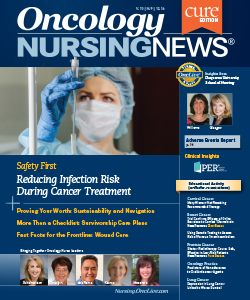Just Bag It Campaign Promotes Safe Vincristine Administration
The NCCN's Just Bag It campaign looks to put an end to the inadvertent inthrathecal administration of vincristine.
Vincristine has been around for decades, and for at least the past 10 years, safety experts and organizations have recommended infusing vincristine in minibags rather than administering it in a syringe using a bolus or “push” administration technique. Inadvertent intrathecal administration of vincristine is neurotoxic and depending on when the error is detected (eg, during administration when a partial dose has been given versus following administration when the entire dose has been administered), patients may be permanently paralyzed or even die.
Making the simple change to administering vincristine in minibags has not been universally accepted. Tragically, in some oncology facilities, vincristine continues to be administered using a syringe and inadvertent intrathecal administration has occurred. It seems unfathomable that this could occur since vincristine is packaged with multiple warning stickers and overwraps, and the recommendation to infuse vincristine in minibags has been around for at least 10 years.
How are these horrific events still occurring? The National Comprehensive Cancer Network (NCCN) notes that 125 deaths have been reported in the United States and abroad since the inception of vincristine use in the 1960s. In addition to published case reports, an unknown number of inadvertent intrathecal vincristine administration events have gone unreported. The commonality in these events is twofold: vincristine was prepared in a syringe, and policies and procedures were not followed. Vincristine was mistakenly injected into the central nervous system rather than given intravenously. This type of error is entirely preventable.
The NCCN, which is best known for its evidence-based chemotherapy treatment and symptom management templates and guidelines, took the unusual step on November 16, 2016 of launching a formal campaign called Just Bag It to promote vincristine safety. It is the first time the NCCN has taken a narrow and very specific safety issue and mandated a practice change for NCCN institutions. The NCCN now joins the Institute for Safe Medication Practices (ISMP), The Joint Commission, the World Health Organization, and the Oncology Nursing Society in advocating for vincristine minibag infusions.
In addition, the updated 2016 American Society of Clinical Oncology/Oncology Nursing Society Chemotherapy Administration Safety Standards (in press) now explicitly state that vincristine is administered in minibags in facilities in which intrathecal medications are administered.
Pushback about vincristine minibag infusions has centered around two concerns. The first is what some have called the unintended consequence of vincristine infusions, which is an increased risk of vesicant extravasation injuries. However, data suggest that this risk is very low regardless of how vincristine is administered.
When 68 cancer treatment centers in Australia standardized vincristine administration to minibag infusions only, researchers tracked the incidence of vinca alkaloid extravasations. When syringes were previously used to administer 37,084 doses of vincristine, 11 extravasations occurred (0.03%). When 7255 doses of vincristine were administered as minibag infusions, 3 extravasations occurred (0.041%). The researchers concluded that the extravasation incidence was similar and infrequent.1
A second issue is the cost differential between syringe and minibag vesicant administration. A minibag of intravenous solution and tubing exceed the cost of a syringe. In addition, a greater amount of pharmacy and nursing time is required to prepare and administer minibags of chemotherapy. However, these concerns are minimal when considered in the context of the degree of harm that may occur from inadvertent intrathecal vincristine administration.
One component of NCCN’s campaign for vincristine safety is recognizing healthcare facilities that have implemented vincristine minibag infusions. All 27 NCCN member institutions have policies that align with NCCN’s recommendations for vincristine safety and are listed on the Just Bag It website (https://www.nccn.org/JustBagIt/).
Other facilities are invited to notify NCCN of their adherence to the Just Bag It campaign by tweeting @NCCNNews with #NCCNJustBagIt and completing an online form. The question for oncology nurses is: Is your facility on the list, and if not, how soon will it be?
Reference
- Gilbar P & Carrington CV. Vinca alkaloid extravasation: Incidence from administration via syringes and minibags [Abstract 94]. Asia-Pacific Journal of Clinical Oncology 2005; 1(Suppl.): A23.
Lisa Schulmeister, MN, RN, ACNS-BC, FAAN, is an oncology nursing consultant and editor-in-chief of Oncology Nursing News.

Innovative Program Reduces Nurse Turnover and Fosters Development
Published: September 12th 2024 | Updated: September 12th 2024The US Oncology Network (The Network) has developed one of the most comprehensive programs in the nation to support the professional development and retention of new oncology nurses.


